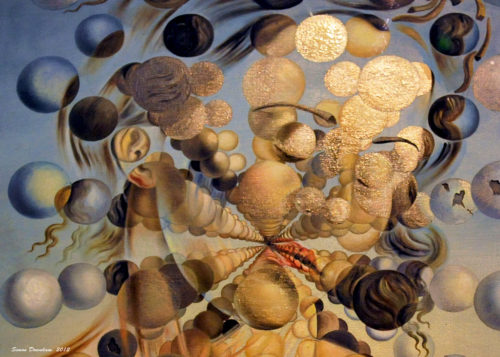The human psyche is always dreaming.
Nature has endowed us with an unconscious mind that perpetually produces streams of images which lie just below the surface of conscious awareness. The unconscious is continually active and never completely turns off. When we sleep, the ego relinquishes control of the mind and allows itself to be submerged back into the depths of the unconscious. During this time, a portion of our awareness stays intact and directly experiences the flow of these images as dreams. A random series of forms cascade over what now remains of the conscious ego. We find ourselves swept along inside of a fantastic story that the psyche simultaneously creates, observes and participates in.
The images we encounter in dreams are symbolic depictions of unconscious processes within the psyche. They animate us from within. They also strive to communicate with the conscious mind and help it to transform. Dream narratives attempt to compensate for the tendency of consciousness to become one-sided and overly literal. When we awaken, the ego reemerges from the depths and regains a sense of authority. Dreams are often quickly forgotten or dismissed by the conscious mind as meaningless fictions, concocted by an unsupervised psyche. Their messages start to sink back down into the unconscious and the images may seem to be irretrievably lost. This is not the case.
The human psyche is always dreaming.
Dreaming does not stop just because we are awake. It only appears to cease because we are distracted by the outer events of life and by waking consciousness. If the conscious mind has been unwilling or unable to decipher the cryptic messages of nocturnal dreams, it is still possible to engage with the contents of waking dreams. Personality transformation absolutely depends upon maintaining this relationship between the ego and the unconscious. It’s the only way the unconscious mind can irrigate the conscious mind and help something new to bloom within the psyche. For this to occur, the conscious mind must release the authoritative grasp it tries to hold on the psyche as a whole. When we allow ourselves to slip into reverie, the images will once again present themselves to us. As a random series of forms float past us, it becomes possible to consciously engage with what we encounter. This is called active imagination. By acknowledging and integrating the imaginal contents of the unconscious mind, we expand the scope of our conscious minds. The process is not without perils. The ego must be strong enough to loosen the filter without becoming completely absorbed back into the unconscious. It also must be flexible enough to let the images permeate the surface of consciousness.
There are dangers and benefits involved in keeping your filter excessively rigid. The main benefit is that you can persist in believing that you have yourself all figured out. You may even get to fancy yourself “sane” or “normal.” This dubious boon comes at the cost of being cut off from the movement of instinctual energy through your personality. This happens when the ego over-identifies with the persona. As a result, we believe that the façade we show to the world is all that we are. Eventually, this results in a sense of alienation from what is truly unique and alive inside of us. We become petrified inside of our own skin. We feel unable to touch, feel or impact the course of our lives. Stagnation ensues.
There are also dangers and benefits involved in greatly loosening the filter:
Someone who cannot integrate the flood of images may become psychotic.
Someone who fully integrates the torrent of images may become a mystic.
Someone who constantly strives to integrate the surge of images may become an artist.
The human psyche is always dreaming.
This article was originally published in the Spring 2016 issue of Catahoula which you can find out more about by clicking here

